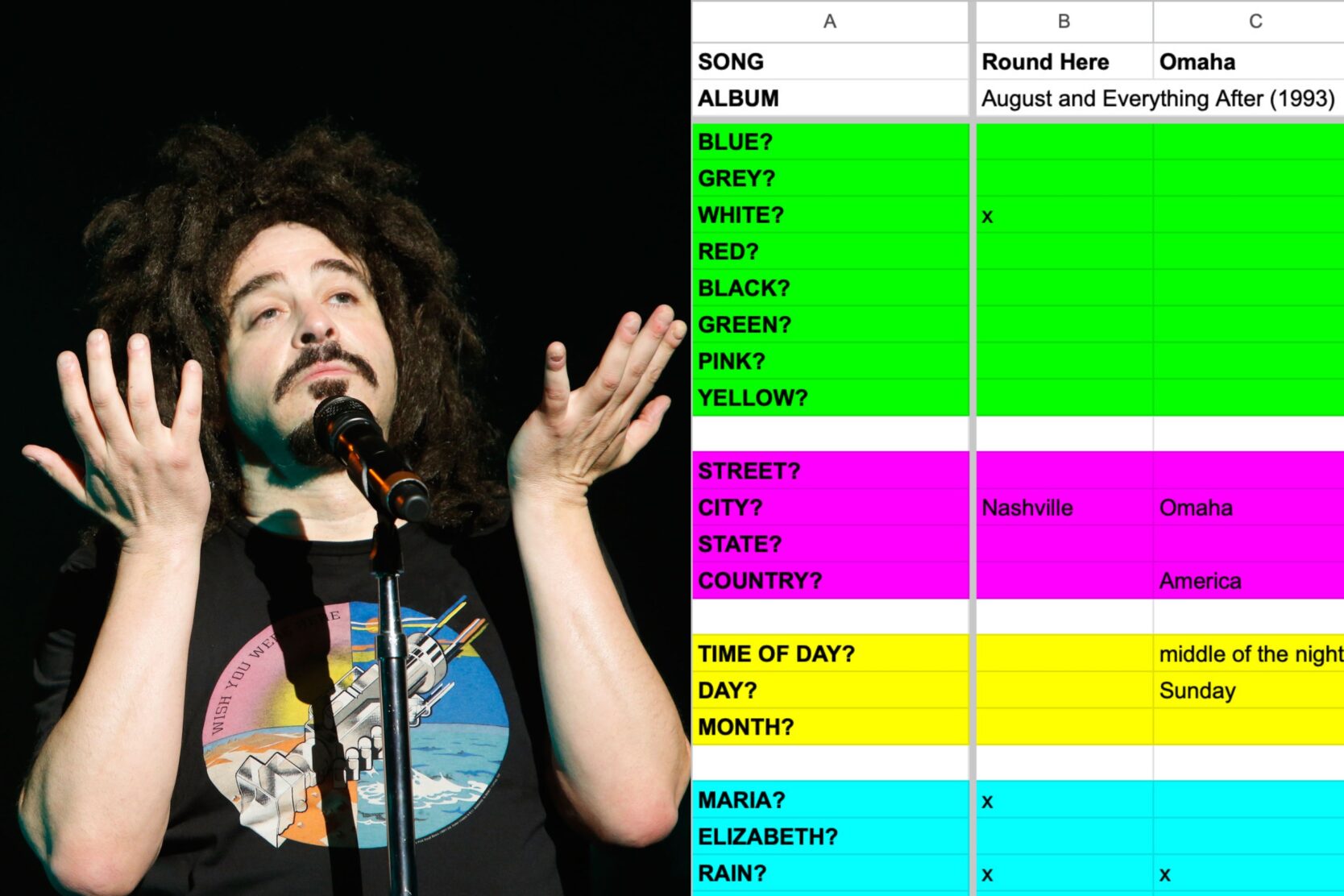Many songwriters have specific lyrical themes that they revisit in song after song. Love, for example. Crying. Dancing. We know the obvious ones. And the Counting Crows are no exception. But the band’s lead singer, Adam Duritz, has distinguished himself from his radio rock peers by fixating on certain niche images and motifs for 30 years—a fixation so committed, so consistent, and, again, so specific, that no other band holds a candle.
With the Counting Crows’ debut album, 1993’s August and Everything After, Duritz established the topics that mattered to him, and he hasn’t deviated since. Being asleep, yes. Rain, for sure. The color blue, obviously. Women named Maria, it should go without saying. But also monkeys. And cowboys. And trains (of the choo-choo variety). Many of the Counting Crows’ most overrepresented nouns could be a wallpaper motif for a six-year-old boy’s bedroom.
As a fan, I long ago noticed that these words appeared in a lot of Counting Crows songs. But how many, really? To answer this vitally consequential question, I knew what I needed to do: make a really big, dumb spreadsheet. On the x-axis, I listed all 76 tracks from the Counting Crows’ six full-length albums and one EP. (I did not include any songs from their 2012 covers album, Underwater Sunshine; nor did I include any live recordings, which are often 12-minute renditions of “Round Here.”) On the y-axis, I listed what I consider to be the 25 most Iconically Counting Crows Elements.
With this spreadsheet, I found that Counting Crows really do sing, as I suspected, a hell of a lot about California (which is mentioned in nine songs), Los Angeles (six songs), Hollywood (five songs, plus the parenthetical title of one additional song), and the ocean/sea (12 songs). And they definitely do sing a lot of songs about ghosts (seven of them, in fact) and trains (11 songs)—not to mention more than you might expect about monkeys (three songs). However, they sing less about birthdays than I’d believed. I somehow had this sense of Adam Duritz warbling endlessly about blowing out candles and feeling alienated at parties, but in fact the topic is mentioned in only three songs and I’d just built it up in my mind. This is why the scientific method is so important.
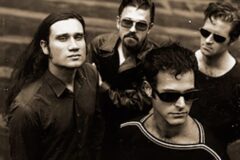
Also Read
30 Overlooked 1994 Albums Turning 30
But these numbers tell only part of the story. For true scientific accuracy, I needed to know whether the Counting Crows sing about these topics with disproportionate frequency. For example, Duritz says the word “the” in most songs, but that’s not remarkable; “the” is one of the most common words in the English language. It doesn’t matter that he mentions rain in 22% of his songs if actually everyone is talking about rain nearly one-quarter of the time.
To answer this question, I enlisted the help of Ryan Micallef, a machine-learning researcher who used AI to compare the Counting Crows’ body of work to the baseline of general English usage. I should be clear that I do not know Ryan, and I don’t think that he cares about the Counting Crows as his only comment on the band’s music was, “The ’90s needed something on the radio, and we couldn’t leave it up to Weezer and Pearl Jam.” However, Ryan asked surprisingly few follow-up questions when I told him that I needed this dataset “for science,” so he seems like a cool dude.
Thus armed, I set off to conduct my analysis of Iconically Counting Crows Elements, hoping to answer the question: What is, lyrically, the most Counting Crows-ish of all Counting Crows songs?
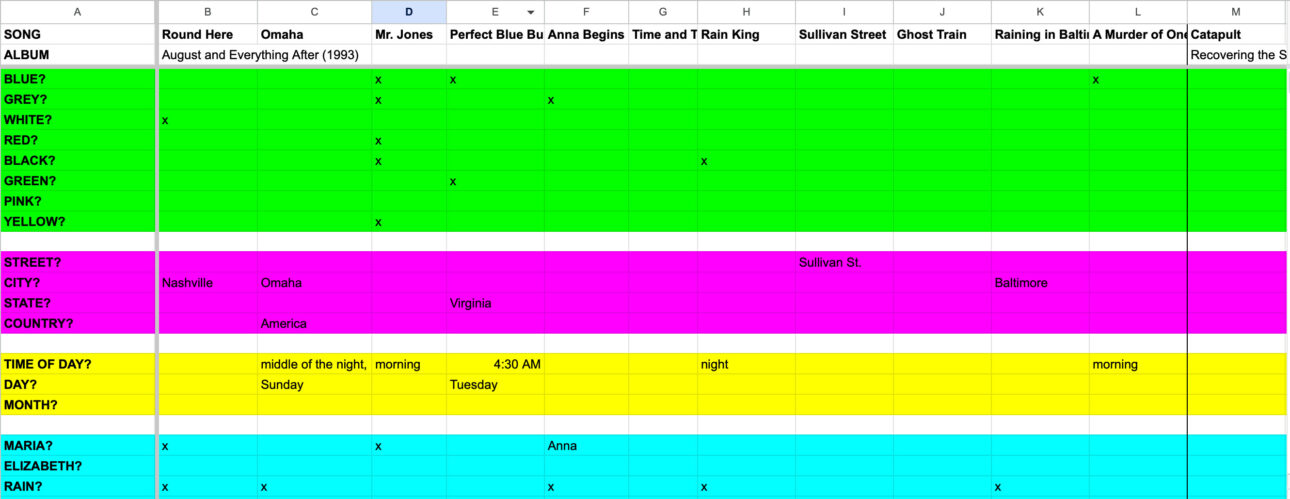
Colors
Even if you’ve only heard one Counting Crows song, it’s “Mr. Jones,” which means even you have heard Adam Duritz rattle off a list of five colors. Forty three percent of their songs mention at least one color, with blue being far and away the most prominent (18 songs), followed by black (13 songs), white (eleven songs), and gray (eight songs).
How many CC songs this concept appears in: 33
Most iconic usage: “I will paint my picture, paint myself in blue and red and black and gray / All of the beautiful colors are very, very meaningful / Gray is my favorite color / I felt so symbolic yesterday / If I knew Picasso, I would buy myself a gray guitar and play.” (“Mr. Jones”)
Maria
Much ink has been spilled over who Maria is. But I am not here to be an investigative reporter, OK? I am here to count crows. So exactly how many songs does this lady’s name appear in? Well, that depends on how you define “Maria.” Technically, it’s in four songs. However, in “Butterfly in Reverse,” Duritz mentions “Marianne,” and it’s not a huge leap of logic to conclude that “Maria” is short for “Marianne.” And once we’ve come that far, “Annie” or “Anna” could be other nicknames for “Marianne.” Which means that the song “Anna Begins” could also be a Maria song. Think about it!
How many CC songs this concept appears in: four, or five, or seven, depending on how willing you are to suspend your disbelief
Most iconic usage: “There’s a piece of Maria in every song that I sing.” (“Mrs. Potter’s Lullaby”)
Sleeping and Dreaming
Adam Duritz sings a lot about things he cannot have, Maria being one of them, and a good night’s sleep being another. Duritz is notoriously bad at sleep and therefore fixated on it. Either sleeping or dreaming or both shows up in literally 50% of Counting Crows songs. In his CD liner-note reflections on the band’s 2002 album, Hard Candy, Duritz said, “I started not sleeping for three or four days at a time, and then passing out for eight hours, and then being up for a couple more days. You start to go crazy after a while, it was sort of nightmarish, but sort of beautiful too. Life becomes very hallucinatory without sleep.” On a personal note, this quote was my AIM away message freshman year of college.
How many CC songs this concept appears in: 16 (sleeping only); 11 (dreaming only), 11 (both sleeping and dreaming)
How disproportionately this concept appears in CC songs vs. baseline usage: 125 times as frequently (dreaming); 5.92 times as likely (sleep), 4.88 times as likely (asleep)
Most iconic usage: “I’ve been up for 38 hours, and it don’t look like sleep’s coming soon.” (“Goodnight L.A.”)
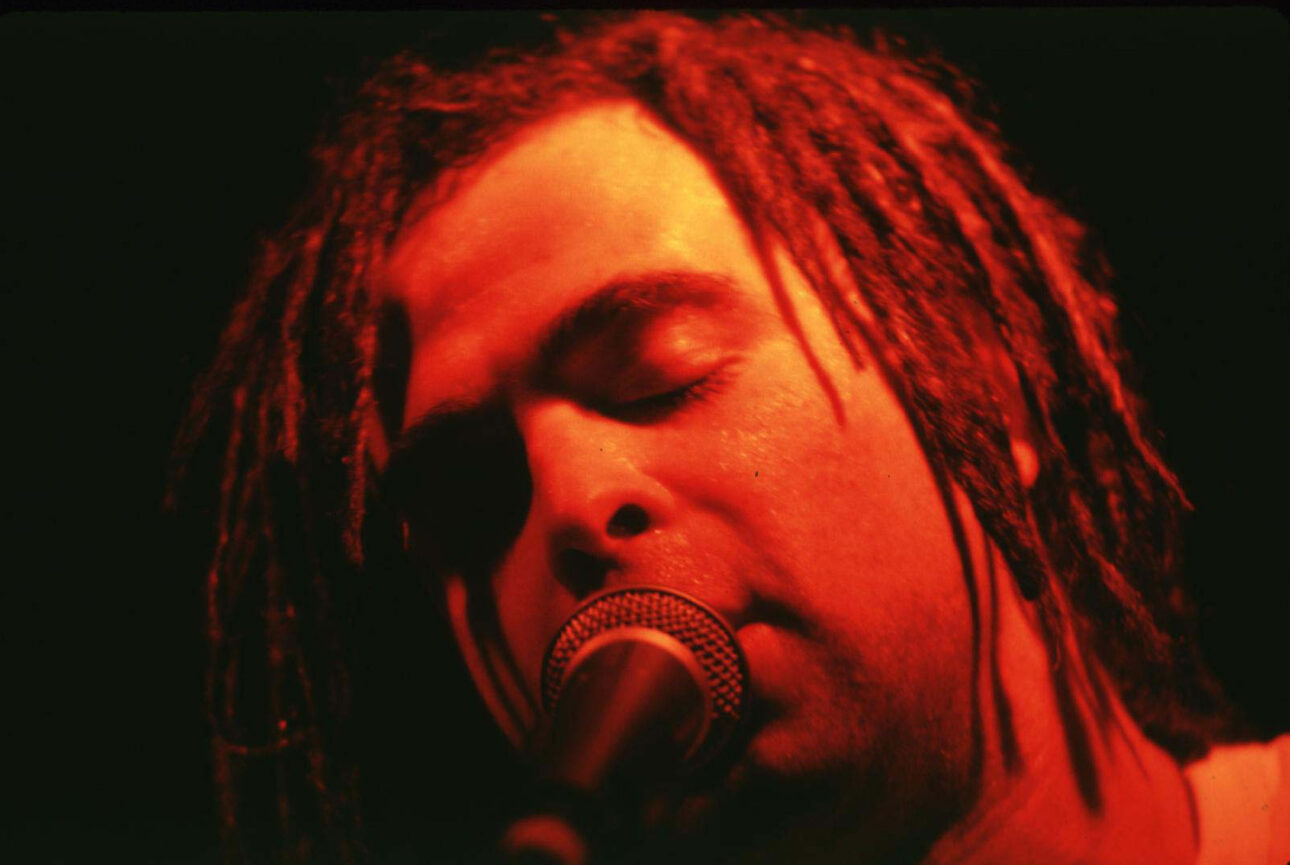
Temporal Locations
Four Counting Crows songs mention months of the year. Those months are November (twice), December (twice), and February. A lot of cold months, in the world of Counting Crows.
Ten Counting Crows songs mention days of the week, and an additional two include days of the week in their titles but not their lyrics. Weekends are heavily overrepresented—not surprising, given that their fifth album was called Saturday Nights & Sunday Mornings. Tuesday also makes a fairly strong showing (two songs, plus one song title). Wednesdays and Thursdays do not exist.
Sixteen Counting Crows songs specify a time of day. As you’d expect, based on Duritz’s sleep schedule, mentioned times include midnight; 1:30 in the morning; sometime after 2 a.m.; 3 a.m.; 4:30 a.m.; and 1-2-3-4-5-6-7 a.m. “Midafternoon” and an hour when “the day was halfway done” are both called out as times when Duritz has just woken up. I do not get the sense that it is ever, like, 5 or 6 p.m. for the Counting Crows. The Counting Crows do not “do” post-work drinks.
Geographical Locations
Four Counting Crows songs across four albums namecheck specific streets, all of them located in lower Manhattan. I, too, do not like to go above 14th Street, so this makes me feel seen.
Sixteen Counting Crows songs name U.S. states. More than half are California, and Duritz definitely leans toward blue states—but not exclusively! Oklahoma, Tennessee, and Mississippi have also popped up in his lyrics. He’s courting a broad political constituency.
Twenty-five Counting Crows songs mention specific cities. L.A. comes in first with six songs. New York City is mentioned in four songs, but all of those are on the same album, so that feels like a passing phase. Anyway, plenty of bands sing about L.A. and New York. The fact that August and Everything After has songs named for both Omaha and Baltimore seems more noteworthy. “Miami” is not the best Counting Crows song named for a city, but it is my favorite.
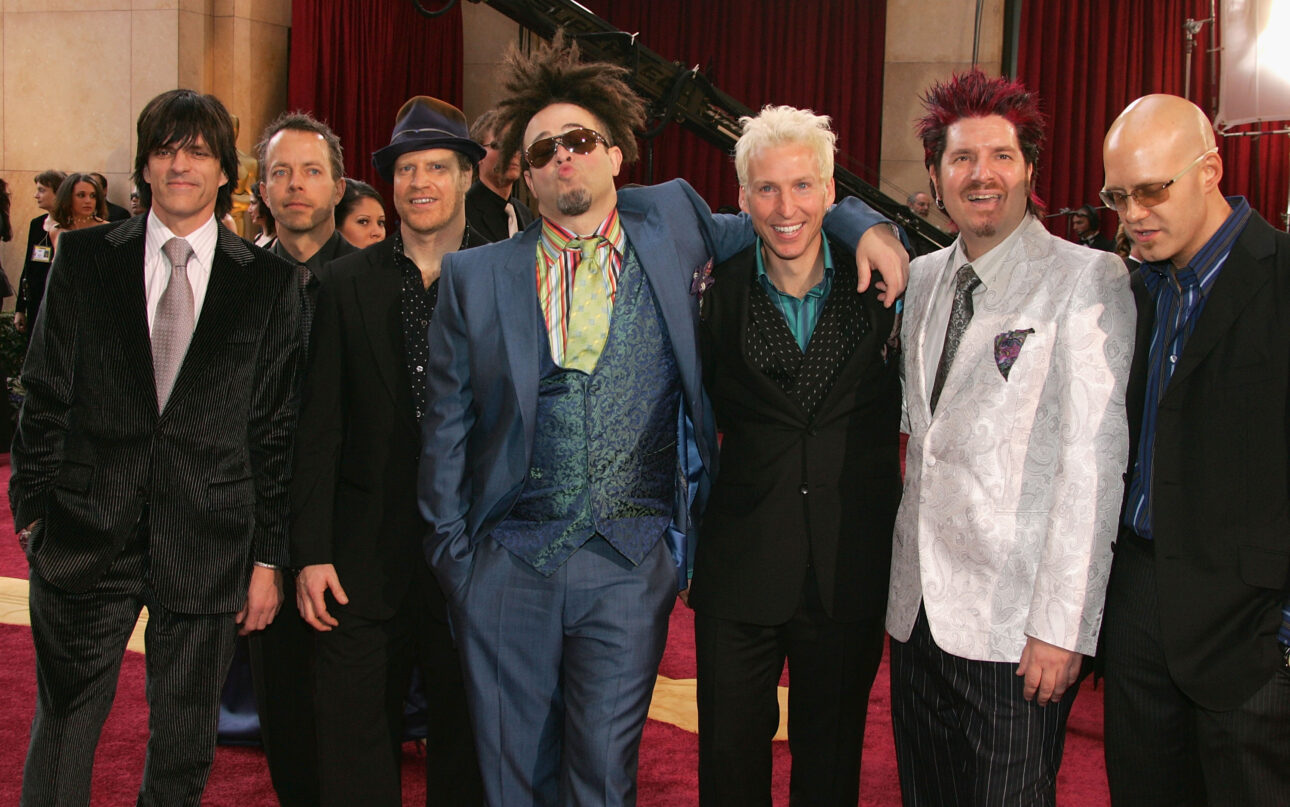
The Circus and Carnivals
You could argue that this is an unfairly broad category, that circuses and carnivals are technically different things. Respectfully, you would be wrong. All the best carnivals include circuses. And both fill the same cultural niche: a timeless tradition of exciting spectacle that passes briefly through a child’s life and then moves on. A technically fun event that is so overwhelming and exhausting that any reasonable kid in attendance will have a complete meltdown. And really, who is Adam Duritz if not a reasonable kid? Lyrically, the Counting Crows love to balance on that tightrope (see what I did there?) between exaltation and devastation. And they love exhaustion. Of course they sing about circuses and carnivals.
How many CC songs this concept appears in: nine
How disproportionately this concept appears in CC songs vs. baseline usage: 17.75 times as frequently (circus); 15.87 times as frequently (carnival)
Most iconic usage: “The circus is falling down on its knees / The big top is crumbling down.” (“Raining in Baltimore”)
Angels
Adam Duritz sings entirely too much about angels for a self-proclaimed “Russian Jew American impersonating African Jamaican.” As a fellow “Russian Jew American” (probably not the order in which I’d string together those words, but I’m an essayist, not a songwriter, so it’s not like I have to worry about meter), I basically never think about angels. Except when I am listening to any of the six Counting Crows albums that mention them.
How many CC songs this concept appears in: 11
How disproportionately this concept appears in CC songs vs. baseline usage: 9.02 times as frequently
Most iconic usage: “’Cause my angel, she don’t receive my calls / Says I’m too dumb to fuck, too dumb to fight, too dumb to save—well, maybe I don’t need no angel at all.” (“Miami”)
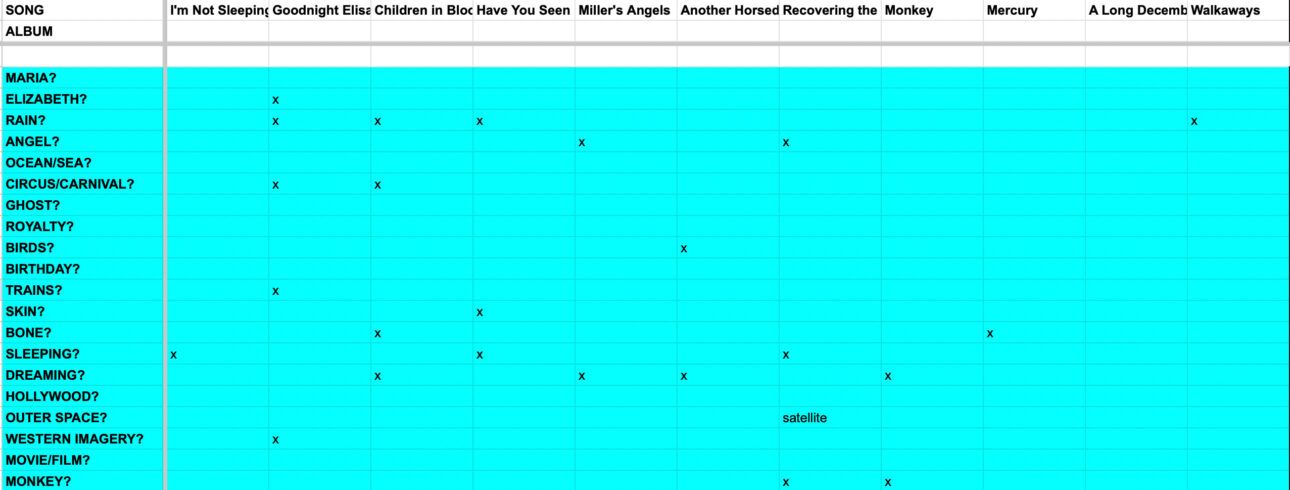
CONCLUSIONS
So, with our data thus analyzed: What is the most Iconically Counting Crows song of all Counting Crows songs?
The first track on their first album, “Round Here,” is a solid contender, as it includes a color, a city, Maria, an angel, a ghost, sleeping, and rain. However, I might have to give the edge to “Mrs. Potter’s Lullaby,” whose lyrics offer up a color, a time of day, another Maria, a circus, a ghost, sleeping, and Hollywood. “Palisades Park” is also way up there: it’s got a color, cities and states, a day of the week, a train, dreams, a rollercoaster, and maybe Maria (assuming you count “Annie” as “Maria,” which, as previously discussed, I do).
So, final conclusion, the most Iconically Counting Crows Song of All Time is: one of those, probably. Or maybe “Rain King.” I’m not choosing. But I will say this: It’s no coincidence that the Counting Crows’ most lyrically consistent songs are also some of their best. Duritz has always been very clear on what his passions are, and the more he explores them, the more compelling his songwriting becomes.

